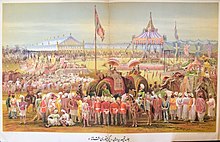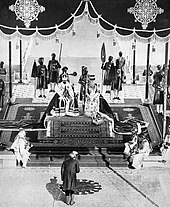Delhi Durbar
The Delhi Durbar (
.Durbar of 1877

Called the "Proclamation
Inside the
We trust that the present occasion
may tend to unite in bonds of close
affection ourselves and our subjects;
that from the highest to the humblest,
all may feel that under our rule the
great principles of liberty, equity,
and justice are secured to them; and
to promote their happiness, to add to
their prosperity, and advance their
welfare, are the ever present aims and
objects of our Empire.
The
It was at this glittering durbar that Ganesh Vasudeo Joshi, wearing "homespun spotless white khadi" rose to read a citation on behalf of the grass roots native political organization, the Poona Sarvajanik Sabha, which organization presaged the later rise of the Indian National Congress. Joshi's speech put forth a demand couched in very polite language:
Her Majesty to grant to India the same political and social status as is enjoyed by her British subjects.
With this demand, it can be said that the campaign for a free India was formally launched,[4] which was the beginning of a great transformation for India.[5]
The durbar would later be seen as controversial because it directed funds away from the
Durbar of 1903
The durbar was held to celebrate the succession of
Edward VII, to Curzon's disappointment, did not attend but sent his brother, the Duke of Connaught who arrived with a mass of dignitaries by train from Bombay just as Curzon and his government came in the other direction from Calcutta. The assembly awaiting them displayed possibly the greatest collection of jewels to be seen in one place. Each of the Indian princes was adorned with the most spectacular of his gems from the collections of centuries. Maharajahs came with great retinues from all over India, many of them meeting for the first time while the massed ranks of the Indian armies, under their Commander-in-Chief Lord Kitchener, paraded, played their bands, and restrained the crowds of common people.[9]
On the first day, the Curzons entered the area of festivities, together with the maharajahs, riding on elephants, some with huge gold candelabra stuck on their tusks. The durbar ceremony itself fell on New Year's Day and was followed by days of polo and other sports, dinners, balls, military reviews, bands, and exhibitions. The world's press dispatched their best journalists, artists and photographers to cover proceedings. The popularity of movie footage of the event, shown in makeshift cinemas throughout India, is often credited with having launched the country's early film industry.[10][11]
The India Post issued a set of two commemorative souvenir sheets with special cancellation struck on 1 January 1903 – 12 noon, a much sought-after item for stamp collectors today.[12]
The event culminated in a grand coronation ball attended only by the highest-ranking guests, presided over by Lord Curzon and
Durbar of 1911



On 22 March 1911, a royal proclamation announced that the Durbar would be held in December to commemorate the coronation in Britain a few months earlier of
The King and Queen left
The Durbar itself was on Tuesday, 12 December, at
On the following day, 13 December, the royal couple made a Jharokha Darshan (balcony appearance) at the Red Fort, to receive half a million or more of the common people who had come to greet them,[15] a custom which was started by Mughal emperors.[20] On 14 December, the King-Emperor presided over a military review of 40,000 troops, culminating in a great cavalry charge. There followed an investiture in Delhi Park, the first was the Queen who received the Order of the Star of India.[15] 26,800 Delhi Durbar Medals in silver were awarded to the men and officers of the British and Indian Armies who participated in the 1911 event. A further two hundred were struck in gold,[21] a hundred of which were awarded to Indian princely rulers and the highest ranking government officers.[22]
Following the Durbar, the King and Queen left for ten days in Nepal, where the King was taken tiger hunting. After visiting Calcutta, they journeyed across India by train to Bombay, which they left on 10 January on RMS Medina.[15]
A feature film of the event titled With Our King and Queen Through India (1912) – also known as The Durbar in Delhi – was filmed in the early color process Kinemacolor and released on 2 February 1912.[23]
Generally the Durbar achieved its purpose of cementing support for British rule among the native princes, as was demonstrated by the support given during the First World War.[15]
Today, the Coronation Park in Delhi is sometimes used for big religious festivals and municipal conventions.[24] The thrones used by King George V and Queen Mary are on display at Marble Hall Gallery and Museum at Rashtrapati Bhavan.[25]
Postponed Durbar of 1937 or 1938

On the
By August 1937, the situation in India had changed. The
Chamberlain was persuaded and initially omitted any mention of royal visit to India from the king's speech of October 1937, but under pressure from the king and against the advice of the viceroy, included the non-committal line; "I am looking forward with interest and pleasure to the time when it will be possible for Me to visit My Indian Empire".[28][29] Linlithgow and Zetland then made a determined effort to dissuade the king from visiting India, even on a more modest scale, using the pretext of finance rather than Indian politics. Quoting a cost of £1 million, all of which would fall on the central government of India and which, they advised, the Indian Finance Minister, James Grigg, was unwilling to support. Finally, in February 1938, the king had to be formally advised by Chamberlain to again postpone any visit "until the general world outlook has become more settled and the financial prospects [are] more definite".[30]
Eventually, the onset of the
Gallery
-
A view of the Durbar Procession of 1903
-
King George V and Queen Maryat the Delhi Durbar 1911
-
Interior of theVictoria Memorial, Kolkata(the inscription is to the right of the statue).
-
Durbar of 1911 in the amphitheater created for the event
-
CommemorativeCalcutta to Delhi
-
Malik Umar Hayat Khan serving as Assistant Delhi Herald Extraordinary in 1911.
References
- ^ "The Imperial Assemblage held at Delhi". Royal Collection Trust. 1 January 1877. Retrieved 4 January 2024.
- ^ The Illustrated London News dated 20 Jan. – 17 Feb., 1877 retrieved 3/18/2007 medal
- ^ Cotton, H. E. A., Calcutta Old and New, 1909/1980, p. 596, General Printers and Publishers Pvt. Ltd.
- ^ The Delhi Durbar, Dimdima.com, magazine of Bharatiya Vidya Bhavan, free india Archived 20 June 2008 at the Wayback Machine
- ^ KESAVAN MUKUL (Sunday, 29 May 2005) "STORY OF THE CONGRESS – Three pivotal moments that shaped early nationalism in India", The Telegraph, Calcutta, retrieved 3/19/2007 nationalism
- ^ Douglas Northrop, An Imperial World: Empires and Colonies since 1750 (Boston: Pearson, 2013), pp. 2–3.
- ISBN 978-1-118-27897-0.
- ISBN 978-1-4597-0756-6.
- (biography) retrieved from Google 3/14/2007
- ^ Holmes Richard, "Sahib: The British Soldier in India 1750–1914". HARPERCOLLINS. 571 pages.
- ^ Bottomore Stephen (Oct, 1995) "An amazing quarter-mile of moving gold, gems and genealogy": filming India's 1902/03 Delhi Durbar, Historical Journal of Film, Radio and Television, includes extensive bibliography of the event, retrieved 3/18/2007 Victoria Memorial Inside 2018 Kolkata
- ^ "India - 1903 King Edward VII Coronation Durbar, Delhi Commemorative Cancellation". Hip Stamp. Retrieved 4 January 2024.
- ^ Cory, Charlotte (2002) Sunday Times, 29 December, retrieved 3/14/2007 "The Delhi Durbar 1903 Revisited",1903 Durbar, extensive description Archived 13 May 2009 at the Wayback Machine
- ^ a b Coronation Durbar, Delhi 1911: Official Directory, with Maps. Calcutta: Superintendent Government Printing. 1911. pp. 1–5.
- ^ a b c d e f g Makin, William J. (1936). The Life of King George the Fifth. London: George Newnes Limited. pp. 164–165.
- ^ "The Imperial Crown of India 1911". www.rct.uk. The Royal Collection Trust. Retrieved 9 October 2022.
- ^ Cox, Noel, A New Zealand Heraldic Authority? in John Campbell-Kease (ed), Tribute to an Armorist: Essays for John Brooke-Little to mark the Golden Jubilee of The Coat of Arms, London, The Heraldry Society, 2000, p. 93 & p. 101
- ^ "Indian maharajah's daring act of anti-colonial dissent". BBC News. 10 December 2011.
- ^ "Delhi Durbar of 1911 - General Knowledge Today". www.gktoday.in. Retrieved 18 February 2018.
- ISBN 9788178660448.
- ^ Howard N Cole. Coronation and Royal Commemorative Medals. pp. 37. Published J. B. Hayward & Son, London. 1977.
- ^ Delhi Durbar Medals of 1911 1911 medal
- ^ Filming the Delhi Durbar 1911 filming Archived 8 July 2011 at the Wayback Machine
- ^ Mukherjee Sanjeeb (Oct. 2001) Coronation Park – the Raj junkyard, the-south-Asian.com, retrieved 3/18/2007 Coronation Park Archived 11 November 2006 at the Wayback Machine
- ^ Presidentofindia.nic.in. "Museum and Galleries in Rashtrapati Bhavan". Archived from the original on 5 May 2012. Retrieved 15 May 2012.
- ^ Bradford 1989, pp. 274-275
- ^ Bradford 1989, pp. 289-290
- ^ "The Kings Speech (1937)". Parliamentary Debates (Hansard). House of Lords. 26 October 1937. Retrieved 29 April 2020.
- ^ Bradford 1989, pp. 290-291
- ^ Bradford 1989, pp. 292-294
- ^ Aldrich 2016, Ch. 15
Bibliography
- ISBN 978-1784993153.
- Army, Indian (1877). Soldiers' games: 'Imperial Assemblage'. Delhi, 3rd January, 1877. s. n.
- Codell, Julie, ed. (2011). Power and Resistance: Photography and the Delhi Coronation Durbars. Ahmedabad: Mapin.
- Codell, Julie (2009), "Indian Crafts and Imperial Policy: Hybridity, Purification and Imperial Subjectivities," Material Cultures, 1740–1920: The Meanings and Pleasures of Collecting. Eds. A. Myzelev & J. Potvin. Aldershot: Ashgate, 149–70.
- Codell, Julie (2004), "Gentlemen connoisseurs and capitalists: Modern British Imperial Identity in the 1903 Delhi Durbar Exhibition of Indian Art," Cultural Identities and the Aesthetics of Britishness. Ed. D. Arnold. Manchester U P, 134–63.
- Fraser, Lovat (1903). At Delhi (An account of the Delhi Durbar, 1903). Bombay : Times of India Press and Thacker.
- Hobbes, John Oliver (1903). Imperial India; letters from the East (Delhi Durbar). London : T.F. Unwin.
- Menpes, Mortimer (1903). The Durbar (Illustrated). London: A & C Black.
- Coronation Durbar Delhi 1911: Official Directory with Maps. The Superintendent, Government Printing, Calcutta. 1911.
- Supplement to Who's Who in India – Containing lives and photographs of the recipients of honours on 12th December 1911. Newul Kishore Press, Lucknow. 1912.
- Raman and Agrawal, Sunil and Rohit (2012). Delhi Durbar 1911: The Complete Story. Delhi: Roli Books.
- Codell, Julie, ed. (2012). Power and Resistance: The Delhi Coronation Durbars. Ahmedabad: Mapin.
External links
- The Coronation Durbar of 1911, film from BFI archives
- Great Coronation Durbar, DELHI video newsreel film Archived 26 August 2011 at the Wayback Machine
- Cornation Durbar films at Internet Movie Database
- "Delhi Durbar" – 1903 – The Coronation of King Edward VII as Emperor of India – Robert W Paul – Documentary on YouTube[dead link]







